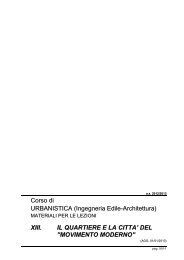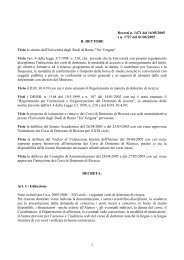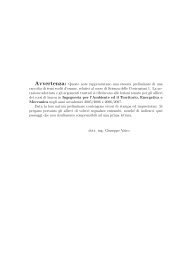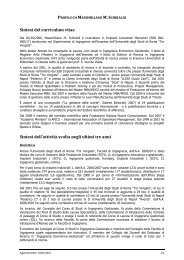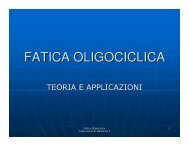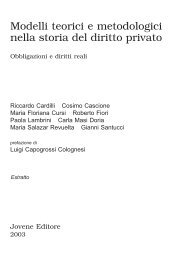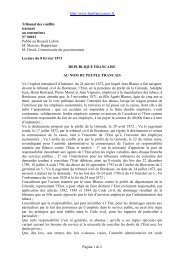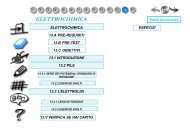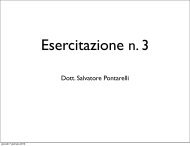Puneet Khandelwal, Soman N. Abraham and Gerard Apodaca
Puneet Khandelwal, Soman N. Abraham and Gerard Apodaca
Puneet Khandelwal, Soman N. Abraham and Gerard Apodaca
You also want an ePaper? Increase the reach of your titles
YUMPU automatically turns print PDFs into web optimized ePapers that Google loves.
An unresolved question is the fate of internalized apical<br />
membrane. As described above, the classical model proposes<br />
that it reestablishes the population of DFV (85, 164). However,<br />
previous studies showed that internalized membrane <strong>and</strong> fluid<br />
are found in multivesicular endosomes/late endosomes <strong>and</strong><br />
lysosomes (6, 36, 87, 164, 171), <strong>and</strong> not in DFV. These studies<br />
indicate that, in umbrella cells, internalized apical membrane<br />
proteins are delivered to lysosomes, where they are degraded.<br />
Consistent with this possibility, the fate of biotinylated apical<br />
membrane proteins internalized in response to stretch is degradation<br />
(205). Furthermore, recent studies in the Buff mouse,<br />
which has a defect in the Sec-1-related protein VPS33a, show<br />
decreased numbers of DFV <strong>and</strong> a dramatic accumulation of<br />
UP- <strong>and</strong> AUM-positive multivesicular endosomes in the apical<br />
cytoplasm of their umbrella cells. VPS33a is one subunit of the<br />
HOPS complex that is important in trafficking steps that lead to<br />
protein degradation in the endosomal system, including multivesicular<br />
endosome-lysosome fusion (162). Thus accumulation<br />
of UPs/AUM in the multivesicular endosomes of Buff<br />
mice could result from defects in endosome/lysosome fusion<br />
(76) <strong>and</strong> is consistent with the notion that endocytosed apical<br />
membrane is delivered to multivesicular endosomes before<br />
degradation in lysosomes. The reason for the decreased number<br />
of DFV in Buff mice is not known but could result from<br />
increases in DFV exocytosis <strong>and</strong>/or apical membrane endocytosis,<br />
or direct fusion of DFV with lysosomes in a process<br />
known as crinophagy (76). Similar to Buff mice the umbrella<br />
cells of KO mice lacking expression of lysosomal integral<br />
membrane protein (LIMP-2) exhibit a paucity of DFV <strong>and</strong> an<br />
accumulation of large numbers of multivesicular endosomes<br />
(67). In addition, the apical plasma membrane of LIMP-2 KO<br />
mice loses its scalloped appearance <strong>and</strong> lacks AUM (67). The<br />
underlying cause of these defects is not well understood, but<br />
the failure to degrade proteins (evidenced by the large accumulation<br />
of multivesicular endosomes) may result in cellular<br />
toxicity similar to that observed in lysosomal storage diseases<br />
(211). Finally, we have followed the fate of membrane <strong>and</strong><br />
fluid-phase markers internalized from the apical surface of the<br />
umbrella cells after voiding <strong>and</strong> observed that these markers<br />
are first delivered to apical endosomes <strong>and</strong> then to lysosomes,<br />
where they are degraded (unpublished observations). Although<br />
our studies do not rule out a role for recycling from apical<br />
endosomes, they indicate that, upon voiding, a significant<br />
fraction of endocytosed marker is delivered to lysosomes, <strong>and</strong><br />
not to DFV.<br />
SENSORY AND EFFECTOR FUNCTIONS OF THE<br />
UROEPITHELIUM: UROEPITHELIUM-ASSOCIATED<br />
SENSORY WEB<br />
Although the barrier function of the uroepithelium has been<br />
appreciated for decades, only recently has it become apparent<br />
that the uroepithelium also plays an important role in transmitting<br />
information about the bladder mucosa <strong>and</strong> its milieu to the<br />
nerve <strong>and</strong> muscle tissues of the bladder. A more extensive<br />
discussion of these issues can be found in a number of recent<br />
reviews (22–24, 50, 80), including one describing the uroepithelial<br />
associated “sensory web” (11). This web includes the<br />
uroepithelium, sensory afferent <strong>and</strong> efferent nerve processes<br />
that innervate the uroepithelium, <strong>and</strong> underlying tissues that<br />
include a subepithelial layer of myofibroblasts <strong>and</strong> the detrusor<br />
THE UROEPITHELIUM<br />
AJP-Renal Physiol • VOL 297 • DECEMBER 2009 • www.ajprenal.org<br />
Review<br />
F1493<br />
muscle. Myofibroblasts arise from fibroblasts that undergo<br />
differentiation into smooth muscle-like cells (30). They are<br />
extensively linked by gap junctions, have close contact with<br />
nerves, <strong>and</strong> may serve as signaling intermediaries between the<br />
uroepithelium <strong>and</strong> nerves (30). Communication between the<br />
tissues that comprise the bladder ensures the proper function of<br />
the organ <strong>and</strong> explains why instillation of mediators such as<br />
ATP, carbachol, nicotine, vanilloid compounds, <strong>and</strong> the nitric<br />
oxide (NO) scavenger oxyhemoglobin into the lumen of the<br />
bladder alters neurotransmission <strong>and</strong> bladder function (13, 19,<br />
46, 50, 64, 113, 150, 156, 157, 161, 173, 219), why the<br />
uroepithelium can modulate the spontaneous activity of the<br />
smooth muscle or muscle contraction (35, 83, 105), <strong>and</strong> why<br />
truncation of the spinal cord disrupts the uroepithelial barrier<br />
(12). The following is an abbreviated description of a proposed<br />
mechanism to explain how bidirectional communication between<br />
the uroepithelium <strong>and</strong> other tissues in the bladder ensures<br />
coordinated bladder function (11).<br />
Sensory input pathways. Within the sensory web, the uroepithelium<br />
acts as a sentinel that receives a broad array of<br />
“sensory inputs” in the form of mechanical stimuli, such as<br />
stretch, mediators present in the urine (e.g., ATP <strong>and</strong> growth<br />
factors), mediators released from nerve processes (e.g., ATP,<br />
substance P, <strong>and</strong> ACh) or other tissues in the bladder, <strong>and</strong><br />
mediators released from the uroepithelium (e.g., ATP <strong>and</strong><br />
adenosine) (Fig. 9). The uroepithelium detects these sensory<br />
stimuli by expressing a large number of surface receptors <strong>and</strong><br />
ion channels, including EGF family ErbB1–3 receptors (15,<br />
209), A1, A2a, A2b, <strong>and</strong> A3 receptors (235), �- <strong>and</strong> �-adrenergic<br />
receptors (20, 26), bradykinin receptors (41), cannabinoid<br />
receptors (74, 220), fractalkine receptor (236), neurokinin<br />
receptor (49), nicotinic <strong>and</strong> muscarinic receptors (M1–M5) (18,<br />
22, 40, 77, 121), purinergic P2X1, P2X2, P2X3, P2X4, P2X5,<br />
P2X6, P2X7, P2Y1, P2Y2, <strong>and</strong> P2Y4 receptors (27, 58, 129,<br />
197, 200, 218, 225), protease-activated receptors (47), VEGF<br />
receptor/neuropilins (39, 176), acid-sensitive ion channels (14,<br />
122), ENaC (61, 134, 224), the NSCC (223, 234), TRAAK<br />
(234), TREK-1 (234), <strong>and</strong> the TRP family channels TRPV1,<br />
TRPV2, TRPV4, <strong>and</strong> TRPM8 (21, 22, 25, 33, 193) (Fig. 9).<br />
Stimulation of these receptors/ion channels may have a<br />
number of consequences. They could alter the solute, water, or<br />
ion flow across the uroepithelium. Alternatively, they may<br />
increase or otherwise modulate membrane turnover at the<br />
apical surface of the umbrella cell. As described above, stimulation<br />
of adenosine receptors, P2X receptors, EGFRs, the<br />
NSCC, <strong>and</strong> ENaC is known to increase membrane turnover<br />
(15, 225, 234, 235). However, it is unknown whether all<br />
sensory input pathways have this effect. Membrane turnover<br />
could serve the following functions. 1) It could modulate the<br />
input response by increasing or decreasing the number of<br />
receptors/channels at the surface of the cell. 2) It could potentiate<br />
or maintain responses by providing a constant supply of<br />
nascent receptors, which would be cleared from the cell surface<br />
after binding their cognate lig<strong>and</strong>s. This may be crucial for<br />
receptors that are constantly exposed to lig<strong>and</strong>s present in urine<br />
<strong>and</strong>/or rapidly desensitize after binding lig<strong>and</strong>.<br />
Sensory output pathways. An additional consequence of<br />
activating sensory input pathways is the release of mediators<br />
from the uroepithelium. These act as “sensory outputs,” which<br />
transmit information to the underlying tissues (Fig. 9). Sensory<br />
outputs that are likely to be physiologically relevant include<br />
Downloaded from<br />
ajprenal.physiology.org<br />
on October 6, 2010



